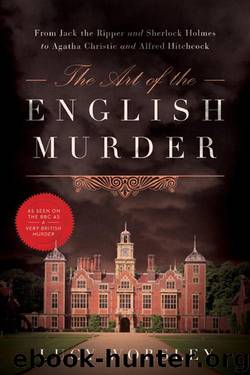The Art of the English Murder by Lucy Worsley

Author:Lucy Worsley
Language: eng
Format: mobi
Publisher: Pegasus Books
Published: 0101-01-01T00:00:00+00:00
14
A New Sensation
‘We look upon the detective officer as the magician of modern life.’
Mary Elizabeth Braddon
A respectable family, a country house, a limited number of suspects, a lower-class investigator lurching in from outside: the crime and setting of the Road Hill House Murder seemed like a real-life equivalent of a rather thrilling new form of literature: the ‘sensation’ novel. And as this new genre developed, details of the Road Hill House Murder would crop up time and time again in its plots.
In the 1860s, the ‘sensation’ novel would come to supersede both the ‘Newgate Novel’ and melodrama as the nation’s favourite form of crime story. Instead of featuring lowlifes and criminals, black and white passions and interventions by Providence, ‘sensation’ novels were set in ordinary domestic situations, often involving the middle- and upper-middle-class families who believed themselves to be too grand to be investigated by the police.
Mary Elizabeth Braddon, one of the ‘sensation’ novel’s greatest authors, pinned down a definition of the type of murder that would now arouse maximum interest in the reading public. It has to be ‘uncommonly cruel, cowardly, and unmanly,’ she wrote, but, most importantly, it had to take place ‘in a respectable rank of life’. The implication that even the best families might have secrets was a pleasantly scandalous notion, and there was something more than a little shocking and improper about a good ‘sensation’ novel. ‘Indications of widespread corruption,’ the philosopher Henry Mansel called these books in 1863, ‘called into existence to satisfy the cravings of a diseased appetite.’
But perhaps the best known of the ‘sensation’ novelists was Wilkie Collins. Henry James later described Collins as ‘having introduced into fiction those most mysterious of mysteries, the mysteries that are at our own doors’. ‘Instead of the terrors of “Udolpho”,’ he continues, ‘we were treated to the terrors of the cheerful country-house and the busy London lodgings.’ Collins’s first success, The Woman in White (published in serial form, 1859–60)., has many of those telltale sensational qualities: a country house, a conspiracy and a mystery solved by an amateurish alliance between the hero and a friend, first-time detectives both.
It was The Moonstone eight years later, however, that became his best-known work, and his first to feature a professional detective. Even though it lacks an actual murder, The Moonstone has nearly everything else one might require from a detective story: a substantial country property as a setting, a closed circle of suspects, a professional investigator, hidden clues, even a style of writing that reads like the presentation of a file of evidence to a court. The solution to the puzzle will defeat all guesses, but it is in fact scrupulously signposted by clues that you will pick up on rereading. This is why T. S. Eliot made the claim that The Moonstone is ‘the first, the longest, and the best of the modern English detective novels’.
Download
This site does not store any files on its server. We only index and link to content provided by other sites. Please contact the content providers to delete copyright contents if any and email us, we'll remove relevant links or contents immediately.
| Anthropology | Archaeology |
| Philosophy | Politics & Government |
| Social Sciences | Sociology |
| Women's Studies |
Cecilia; Or, Memoirs of an Heiress — Volume 1 by Fanny Burney(32440)
Cecilia; Or, Memoirs of an Heiress — Volume 2 by Fanny Burney(31875)
Cecilia; Or, Memoirs of an Heiress — Volume 3 by Fanny Burney(31858)
The Great Music City by Andrea Baker(31539)
We're Going to Need More Wine by Gabrielle Union(18973)
All the Missing Girls by Megan Miranda(15598)
Pimp by Iceberg Slim(14399)
Bombshells: Glamour Girls of a Lifetime by Sullivan Steve(13979)
Talking to Strangers by Malcolm Gladwell(13233)
Norse Mythology by Gaiman Neil(13217)
Fifty Shades Freed by E L James(13163)
For the Love of Europe by Rick Steves(13128)
Mindhunter: Inside the FBI's Elite Serial Crime Unit by John E. Douglas & Mark Olshaker(9212)
Crazy Rich Asians by Kevin Kwan(9174)
The Lost Art of Listening by Michael P. Nichols(7412)
Enlightenment Now: The Case for Reason, Science, Humanism, and Progress by Steven Pinker(7242)
The Four Agreements by Don Miguel Ruiz(6641)
Bad Blood by John Carreyrou(6559)
Weapons of Math Destruction by Cathy O'Neil(6152)
